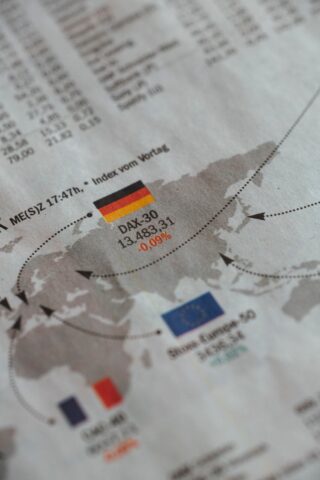
Photo de Markus Spiske sur Pexels: https://www.pexels.com/fr-fr/photo/drapeaux-de-l-allemagne-de-l-ue-et-de-la-france-dans-le-journal-3806756/
By Zubic Alexandru
When we talk about the EU’s foreign policy activity in International Organizations, it is worth mentioning that at the present stage the European Union is active within a number of international organizations. In particular, in the framework of the World Trade Organization (WTO), the EU has been a member since its first day of existence, January 1, 1995, despite the fact that the EU itself is not a state.
History of the creation of the WTO
The WTO was founded in 1995 on the basis of the GATT (General Agreement on Tariffs and Trade) agreement. It is an institutional forum where governments can negotiate trade agreements and settle trade disputes through a system of trade rules. The WTO is a development and continuation of GATT achieving its stated objectives, but unlike the latter, it is a permanent international organization, which regulates almost all areas of international trade and has a clear structure and a solid legal framework (the Agreement establishing the WTO, the Agreement on Subsidies and Countervailing Measures, GATT, the Agreement on Standards, etc.).
Participation of the European Union in the WTO
Peculiarities of the EU’s participation in the WTO are that, for example, unlike the IMF, the EU is a full member of the Organization and thus participating in full parity with other states. Moreover, historically the EU (and before that the European Community) was the most active participant in the process of establishment of the WTO in the modern sense. Since by virtue of the EU’s founding documents, trade policy is the exclusive competence of the Union authorities, the EU acts directly on behalf of its 27 member States but the EU Member States themselves are also direct WTO members.
The fact that Europe is the largest trader in the world, responsible for about a fifth of world trade in goods and services, directly defines the relationship between the EU and the WTO as one of the cornerstones of modern, global governance. In addition, the membership of the European Union in international organizations is an important issue, since they are playing a major role both in regional and in global cooperation among states.
The EU is a key actor within the WTO
It should be understood that here we should take into account the way the EU Member States make decisions in the WTO: they face double pressure in these negotiations, both from the partners in the negotiations and from the Member States. Thus, we can also distinguish the so-called four “sources of EU strength” in the WTO, which are mentioned below:
- The economic presence of the European Union and its overall power (i.e. the growth of EU economic power has turned the Union into one of the key global players competing with the US). The GDP indicator can serve as a clear and fresh example. In the top ten are two European Union countries, namely Germany and France. It is also worth paying attention to Italy, Spain and the Netherlands, which are in the second top ten in terms of GDP. Thus, we can make a small conclusion – every fourth country in the top twenty countries in terms of GDP are members of the European Union;
- Direct use of economic policy (i.e. that the European Union is increasingly willing and able to use its trade capabilities to achieve political objectives);
- The role model (i.e., that the EU’s economic attractiveness as a partner and willingness to enter into a cooperation agreement has led to the EU becoming a role model for many countries in the context of trade and economic policy);
- Institutional structure (i.e., that the institutional structure of the EU works in favor of 27 states).
Conflict of interest between the EU and the WTO
If we have talked about the advantages, it is worth paying attention to the disadvantages. The so-called “GMO dispute” is a telling example of how the EU has faced a radically different viewpoint from other WTO member states. In 2003, the US, Canada and Argentina filed a lawsuit against the EU. The point is that in the early 1990s the EU approved the use of a number of GMO crops but after a number of epidemics and outbreaks of various diseases, the approval process of GMO in the EU countries was suspended, and in some EU Member States GMO was banned altogether. In a 2003 lawsuit, the plaintiff states sought to open the European market to GMO products. The EU tried to appeal that the laws regarding GMOs had been updated, which no longer created obstacles for plaintiff countries, but a check showed that eight of the nine countries that had introduced national bans refused to repeal them.
In the end, the WTO found that the new rules had been unduly delayed, but refused to consider Argentina and Canada’s argument that GMO crops were “like” their natural counterparts, which would have meant that any barrier against them would have been contrary to WTO law. In 2009, the parties to the conflict signed a final settlement of the dispute. Thus, the parties to the dispute were able to reach an alternative agreement despite the contradictions in their points of view.
Thus, we can make a conclusion that in the context of international negotiations, the EU is usually seen as a conservative actor, constrained by time-consuming procedures for obtaining support from the 27 Member States and institutional constraints.
In the future, however, the specific context of the negotiating arena will play an important role in determining when and how the EU will be more flexible and innovative in its negotiating power as well as its activity within the World Trade Organization. For its part, the EU was able to successfully resolve the difference in approach between it and other WTO countries, thereby not violating either its own legislation or that of the international organization.
